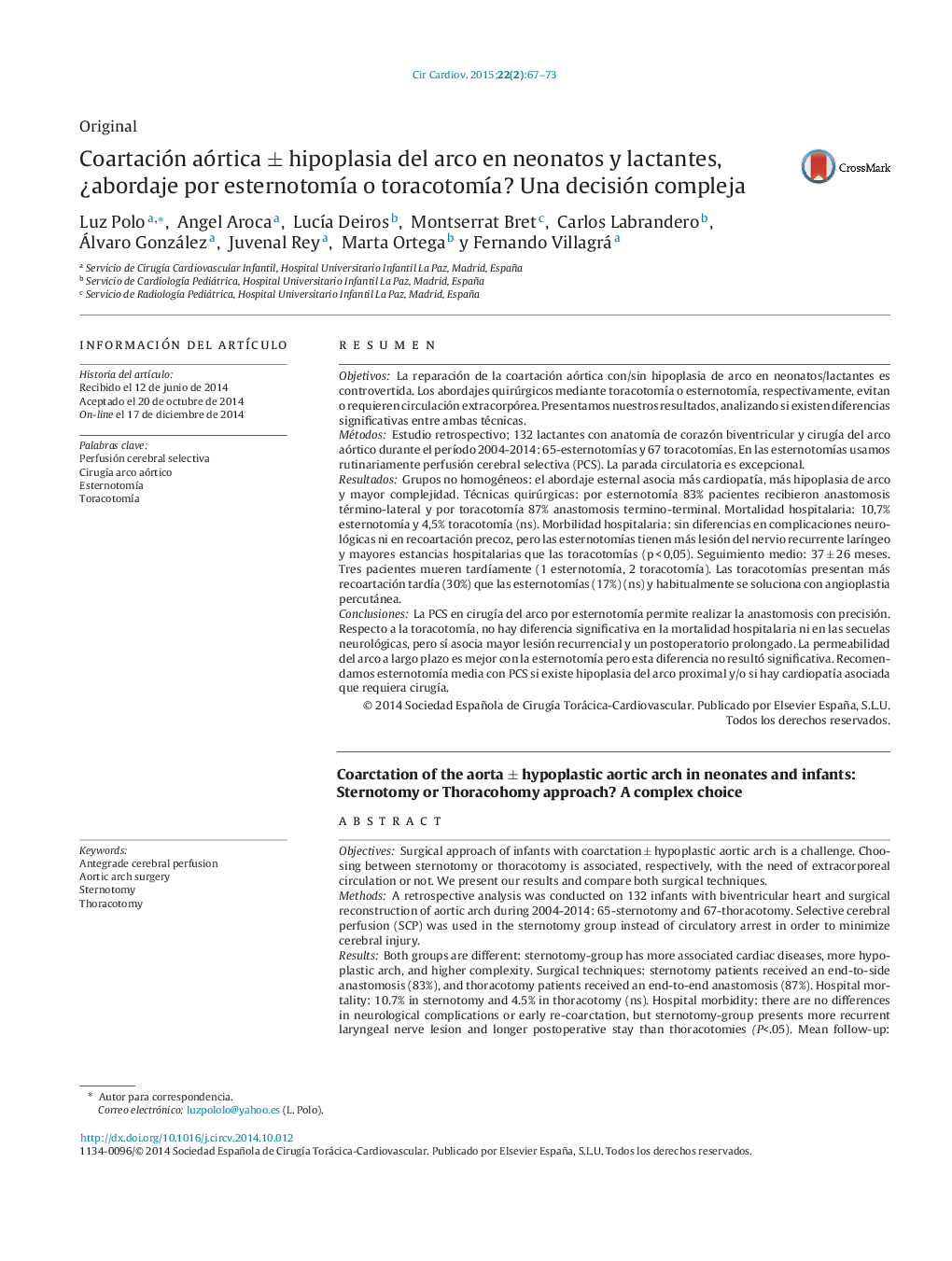| Article ID | Journal | Published Year | Pages | File Type |
|---|---|---|---|---|
| 2907959 | Cirugía Cardiovascular | 2015 | 7 Pages |
ResumenObjetivosLa reparación de la coartación aórtica con/sin hipoplasia de arco en neonatos/lactantes es controvertida. Los abordajes quirúrgicos mediante toracotomía o esternotomía, respectivamente, evitan o requieren circulación extracorpórea. Presentamos nuestros resultados, analizando si existen diferencias significativas entre ambas técnicas.MétodosEstudio retrospectivo; 132 lactantes con anatomía de corazón biventricular y cirugía del arco aórtico durante el período 2004-2014: 65-esternotomías y 67 toracotomías. En las esternotomías usamos rutinariamente perfusión cerebral selectiva (PCS). La parada circulatoria es excepcional.ResultadosGrupos no homogéneos: el abordaje esternal asocia más cardiopatía, más hipoplasia de arco y mayor complejidad. Técnicas quirúrgicas: por esternotomía 83% pacientes recibieron anastomosis término-lateral y por toracotomía 87% anastomosis termino-terminal. Mortalidad hospitalaria: 10,7% esternotomía y 4,5% toracotomía (ns). Morbilidad hospitalaria: sin diferencias en complicaciones neurológicas ni en recoartación precoz, pero las esternotomías tienen más lesión del nervio recurrente laríngeo y mayores estancias hospitalarias que las toracotomías (p < 0,05). Seguimiento medio: 37 ± 26 meses. Tres pacientes mueren tardíamente (1 esternotomía, 2 toracotomía). Las toracotomías presentan más recoartación tardía (30%) que las esternotomías (17%) (ns) y habitualmente se soluciona con angioplastia percutánea.ConclusionesLa PCS en cirugía del arco por esternotomía permite realizar la anastomosis con precisión. Respecto a la toracotomía, no hay diferencia significativa en la mortalidad hospitalaria ni en las secuelas neurológicas, pero sí asocia mayor lesión recurrencial y un postoperatorio prolongado. La permeabilidad del arco a largo plazo es mejor con la esternotomía pero esta diferencia no resultó significativa. Recomendamos esternotomía media con PCS si existe hipoplasia del arco proximal y/o si hay cardiopatía asociada que requiera cirugía.
ObjectivesSurgical approach of infants with coarctation ± hypoplastic aortic arch is a challenge. Choosing between sternotomy or thoracotomy is associated, respectively, with the need of extracorporeal circulation or not. We present our results and compare both surgical techniques.MethodsA retrospective analysis was conducted on 132 infants with biventricular heart and surgical reconstruction of aortic arch during 2004-2014: 65-sternotomy and 67-thoracotomy. Selective cerebral perfusion (SCP) was used in the sternotomy group instead of circulatory arrest in order to minimize cerebral injury.ResultsBoth groups are different: sternotomy-group has more associated cardiac diseases, more hypoplastic arch, and higher complexity. Surgical techniques: sternotomy patients received an end-to-side anastomosis (83%), and thoracotomy patients received an end-to-end anastomosis (87%). Hospital mortality: 10.7% in sternotomy and 4.5% in thoracotomy (ns). Hospital morbidity: there are no differences in neurological complications or early re-coarctation, but sternotomy-group presents more recurrent laryngeal nerve lesion and longer postoperative stay than thoracotomies (P<.05). Mean follow-up: 37 ± 26 months. Three patients died in the follow-up (1-sternotomy, 2-thoracotomy). Late re-coarctation is more frequent in thoracotomy (30%) than in sternotomy (17%) (ns) and is generally treated with percutaneous angioplasty.ConclusionsSCP in sternotomy approach of arch surgery allows the surgeon to perform the anastomosis in a bloodless field, and preserves neurological function. Sternotomy, in comparison with thoracotomy, has similar mortality, a higher recurrent nerve lesion, and prolonged hospital stay. Sternotomy seems to be associated with a lower incidence of re-coarctation in the follow-up. Sternotomy with SCP is recommended if there is hypoplastic aortic arch and/or associated cardiac diseases needing surgery.
